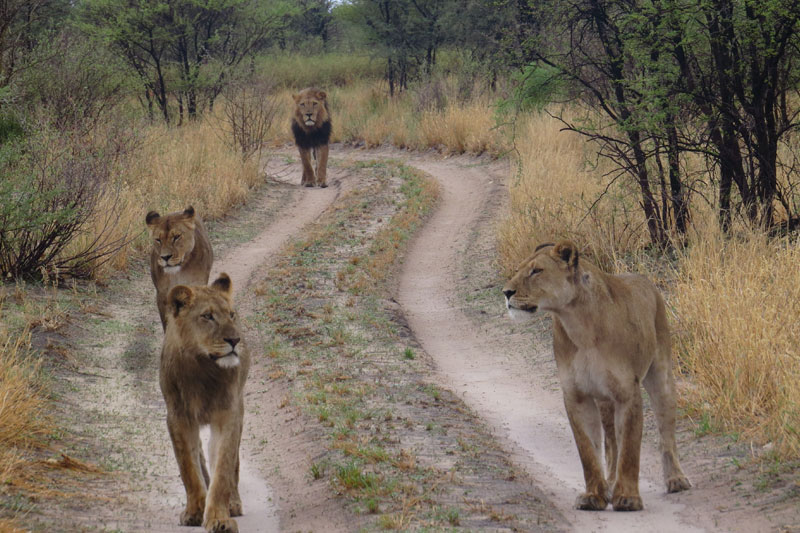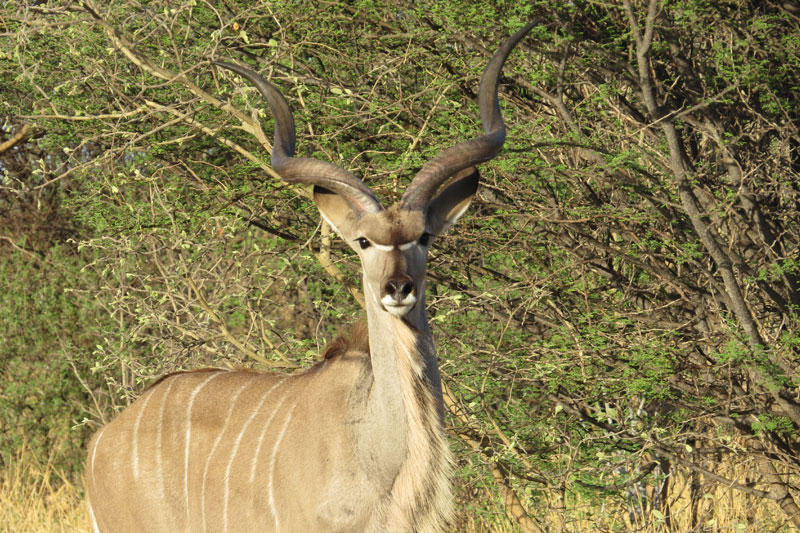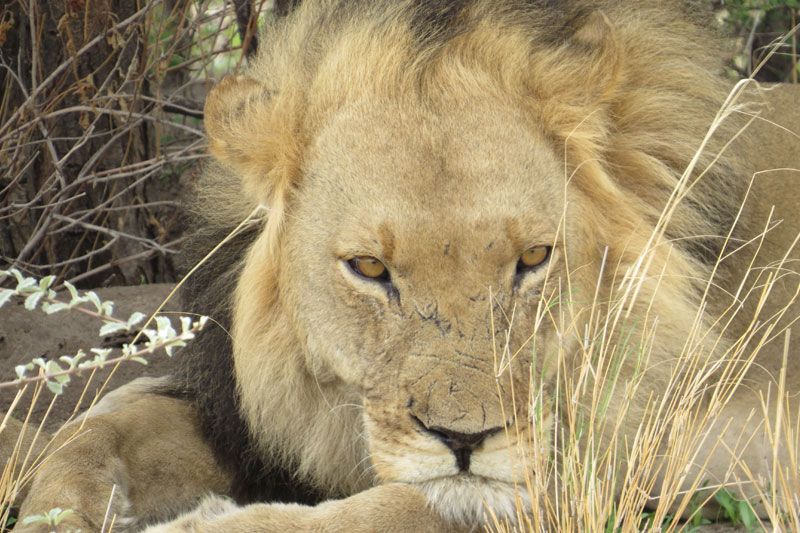Julia and I set off from London on an unusually cold November evening to arrive in the stark Makgadikgadi Pans in Botswana the next day with temperatures soaring above 40 degrees – what a contrast! This was my third visit to Botswana but my first to the desert regions of the Makgadikgadi Pans and the Central Kalahari. Botswana is known for absolute exclusivity, arguably more than any other country in Africa, but also for its diversity of activities and landscapes, and we discovered that these two regions really do add a whole other dimension to a Botswana safari.
We spent our first two nights at the delightful Camp Kalahari in the Makgadikgadi Pans and our time was full with a whole range of activities. The moment we were picked up from the airstrip we were fascinated by the northern black korhaan, also known as the helicopter bird for their graceful landings, and we were blown away by the stunning salt pans stretching ahead of us. I have a real affection for doum palm trees all across Africa and they really do typify the landscape in the Makgadikgadi – the everlasting horizon interrupted by the grand silhouettes of the palm trees and the silence broken by the gentle rustling of the leaves.



One of the reasons to include the Makgadikgadi in your itinerary would be for the chance to see specialist desert species, and we had amazing sightings of bat eared fox, jackal and scrub hare in broad daylight. In addition we were extremely lucky to come across a brown hyaena mother tackling the mammoth task of moving two of its pups less than a month old across a vast salt pan, just as the sun was setting. More beautiful than the widely known spotted hyaena, the brown hyaena is mostly solitary and usually very shy. We sat and watched as the hyaena tried to somehow transport one pup in its mouth and hopefully persuade the second pup to follow (it never did!). It was a beautiful and almost comical sight to witness in the grandest of locations.



One of the real highlights of these areas are the local San Bushmen. We stayed at three different properties, Camp Kalahari in the Makgadikgadi, Tau Pan in the Central Kalahari Game reserve and Dinaka, bordering the Central Kalahari Game Reserve. At each property, we enjoyed a walk with the local San bushmen and each walk was delightful and different. The San are incredibly charismatic, vibrant people and each guide had a cheeky glint in their eye and an amusing story to share. Each walk we learnt new fascinating facts about how they lived in the bush and used it as their local pharmacy, hardware shop, supermarket and clothes store – it was mesmerising and admirable. At Camp Kalahari, we were guided by a group of 10 San Bushmen, walking through the bush. They all spoke loudly and nonstop to each other as they moved through the bush which made for a lively atmosphere. At one point, we stopped at a bush that had sap pouring out of the branches, and they all ran to the tree and started to eat the sap as if they were children in a sweet shop – it was incredible to watch the joy it brought them. We came across a zebra carcass and one of the senior men decided to keep its mane for a hat. We sat with them in the bush and they demonstrated one of their traditional games, which turned out to be a very similar game to our “Rock, Paper, Scissors.”
At Tau Pan, our guide Scuba showed us how to make fire, and sang a beautiful song, using an instrument fashioned out of wood and metal. At Dinaka, we were in awe of the bushmen’s bow and arrow skills – when we had a go ourselves, it made it all the more impressive to see how far and how accurately they could shoot their arrows.



One of our afternoons in the Makgadikgadi consisted of a walk with the meerkats. There are a number of habituated groups and you can spend some time with them on foot, as they busily forage the ground for insects and bugs. They don’t take much notice of you, but are forever on the lookout for predators, on their hind legs scanning their surroundings. It was a wonderful experience and was an opportunity to see the pans from a different angle.
In the dry season (from June through to October), it is also possible to experience the vast salt pans on quad bikes, to get a true sense of the huge space and landscape. Unfortunately we were too late to experience this, but I can only imagine the sense of freedom you must feel when out in the middle of the pans. The Makgadikgadi is an amazing landscape and a total contrast to the waterways of the Okavango Delta and the big game of the Chobe and Savute. It is not an area for ticking off big game, but if you want a varied itinerary it is such a rewarding location to include.



In the Central Kalahari Game Reserve, we had the opportunity to drive through Deception Valley, and it proved to offer a stark landscape. They had not had much rain yet which meant the game viewing was a challenge, though experiencing such a vast wilderness was inspiring. This area is one of the few locations in Africa where the game viewing is better in the wet season. Our guide explained that as the rains come, the pans and Deception Valley would be covered in the grass, which attracts the plains game which in turn attracts the predators. From December through to March, this area comes into its own. Despite the dry conditions, we still had an amazing sighting of the Kalahari lions – three females and two huge black-maned males silently padding down the road past our vehicle, their stare was haunting. The night before they had been roaring loudly all around the lodge, so close I felt like they were outside our room. On closer inspection with our guide the next morning, they were in fact directly outside our room. Tau means Lion in Setswana so Tau Pan very much lived up to its name.
Our stay at Dinaka was equally wonderful. The camp, now run by Ker and Downey, has a beautiful setting. Being a private reserve, with a fenced perimeter, the wildlife is good all year round, coming into its own in the dry season. While it doesn’t offer the vast wilderness feel of being in the reserve, it does offer the Kalahari habitat and good game viewing, with sightings of lion and rhino possible as well as a variety of activities. There are photographic hides/bunkers, a sleepout deck, night drives, an active waterhole in front of camp and a cheeky resident honey badger who makes himself known in the evenings. It’s a delightful property offering good hospitality and a great combination with their other properties in the Okavango Delta.



We continued our trip into the Okavango Delta and the Linyanti which Julia has detailed in her trip report. The Delta was incredible, its waterways and many islands are one of my favourite locations in Africa, though the drought this year meant that the water in the Delta was hard to come by. This trip made me fall in love with Botswana even more – there is something quite amazing about travelling from the vast salt pans of the Makgadikgadi and the stark wilderness of the Central Kalahari, to the lush waterways of the Okavango Delta and the incredible big game of the Linyanti Region.
Fran and Julia stayed at: City Lodge O.R. Tambo, Camp Kalahari, Tau Pan, Dinaka, Chitabe Camp, King’s Pool, Vumbura Plains South Camp, David Foot Walking Safaris, Kwara Camp, Sable Alley.
Fran and Julia site inspected: Jack’s Migration Camp, Jack’s Camp, San Camp, Kalahari Plains, Chitabe Lediba, Mma Dinare, Rra Dinare, Gomoti plains, Gomoti Private, Qorokwe, Savuti Camp, Duma Tau, Vumbura Plains North Camp, Little Vumbura, Splash Camp, Jackal and Hide, Tuludi, Saguni, Khwai Tented Camp, Machaba and Little Machaba.
